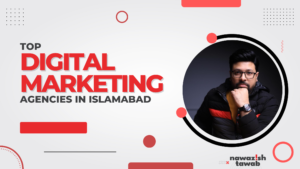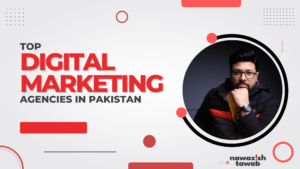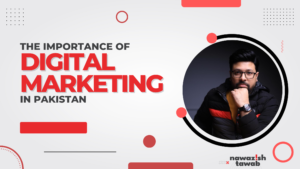Marketing plays a vital role in helping businesses reach their audience, share their brand’s message, and boost sales. The world of marketing is evolving, with digital marketing emerging as a game-changer. In this guide, we’ll explore the difference between digital and traditional marketing, providing valuable insights for business owners, marketers, and SEO enthusiasts looking to tap into the potential of modern marketing strategies.
What is Digital Marketing?
Digital marketing uses the internet and digital tech to promote stuff. It includes things like ads on social media and SEO. What’s cool about digital marketing is that it can reach people where they spend a lot of time – online.
What is Traditional Marketing?
Old-school marketing covers any type of promotion that doesn’t happen online. This includes stuff like ads in newspapers, on TV or radio, mail sent directly to your mailbox, and ads you see outside. These ways have worked well in the past but usually reach a lot of people rather than a specific group.
Channels of Communication
Marketers use many different platforms to share their messages and have various strategies to create those messages. Knowing these platforms well can either lead to success or cause a business to struggle in today’s competitive market.
Digital Marketing
In digital marketing, the internet’s quickness and interaction create fresh ways to communicate. Users aren’t just passive receivers; they actively take part in marketing. Instant feedback helps tweak and personalize campaigns right away.

Websites
A business’s website is like its digital storefront. In digital marketing, it’s prime real estate. Websites are where online activity happens. They attract potential leads. They help customers understand your offerings better. SEO and content marketing are crucial. They boost your website’s search engine ranking. They deliver informative and engaging content.
Social Media
With billions of users around the globe, social media platforms offer fantastic opportunities to connect with audiences. By using sponsored content, collaborating with influencers, and encouraging organic engagement, social media can help build strong brand awareness and loyalty. It’s essential to grasp the distinct characteristics and demographics of each platform to customize your strategy and achieve the best results.
Email marketing plays a crucial role as the unsung hero by enabling direct communication with a specific audience. This channel offers a personal touch and, when utilized effectively, can lead to impressive open and conversion rates. Success hinges on maintaining a delicate equilibrium between frequency, engaging content, and respectful interactions to steer clear of spam territory.
Search Engines
SEO and pay-per-click (PPC) are crucial for online visibility. They help attract customers looking for solutions. To succeed, focus on keywords and top-notch content. For PPC, smart bidding and ad creation are key for ROI.
Traditional Marketing
Traditional marketing, on the other hand, relies on one-way communication, with brands pushing messages out to people via television, radio, billboards, and print media. While this is tried and tested, it lacks the depth of engagement made possible by digital platforms.

Print Advertisements
Print ads have been around for ages in magazines and newspapers. They are cool because they’re real things you can touch, unlike digital ads. They look awesome with fancy designs and stuff that interests you. But yeah, printing can be pricey, and tracking their success can be tricky.
Broadcast Media (TV, Radio)
TV and radio are special because they blend images and sound to tell captivating stories that connect with viewers. They reach many people, but advertising on them can be expensive, and figuring out how well they work can be tough.
Direct Mail
Direct mail campaigns offer a hands-on brand experience. You can customize them and they stand out more than emails. Yet, creating and sending direct mail can be costly.
Outdoor Advertising (Billboards, Posters)
Outdoor ads play a big role in our surroundings and are visible around the clock. They help people recognize brands easily. However, they lack interaction and can be expensive to target specific audiences or locations.
Target Audience
The crux of any successful marketing campaign is the target audience. Defining and understanding this group allows for the crafting of messages that resonate and drive action.
Digital Marketing
Specific and Targeted Demographics and Interests
With advanced tools, digital marketers target specific demographics and interests. Tailoring ads reaches the right audience. Retargeting gently nudges those hesitant back to your product. Segmenting data is a game-changer in digital marketing.
Traditional Marketing
Broad and Less Targeted Audiences
Traditional methods reach a wide range of people, which can be helpful. However, these methods may not connect as well with specific groups, which could result in resources being used less effectively.
Measurement and Analysis
The ability to measure the effectiveness of a marketing campaign is important. It informs future strategies and allows businesses to adjust their approach in real time for optimum results.
Digital Marketing
Digital tools help us understand customer behavior, how well our campaigns are doing, and if our strategies are working. With these detailed insights, marketers can make smart decisions based on data instead of just guessing.
Advanced Analytics and Tracking Tools
Digital marketing offers a standout feature with its range of analytics and tracking tools. These tools help marketers closely examine how well their campaigns are doing. By using data-driven insights, marketers can make smart choices and improve their marketing efforts for real, measurable success.
Real-time Data on Campaign Performance
Today’s marketing world moves quickly, especially in digital marketing. Marketers can easily see how their campaigns are doing in real time, allowing them to adjust strategies instantly, unlike traditional marketing methods that take longer to adapt. This flexibility in digital marketing helps campaigns reach their full potential.
Traditional Marketing
Measuring old-school marketing has usually been kind of fuzzy. Even with tools and surveys to collect data, we still have to guess and interpret a lot. The data might be off, which makes it tough to clearly connect how well a campaign did to certain marketing strategies.
Limited Measurement Capabilities
In a typical marketing setup, it can be challenging to fully measure the impact of a campaign. Methods such as coupon redemptions or tracking phone inquiries are available, but they may not offer as much detailed information as digital metrics do. This can result in marketers having a somewhat less precise understanding of their return on investment (ROI).
Rely on Estimates and Surveys
One common method to measure a campaign’s success in traditional marketing is through surveys and estimates. However, this approach can be time-consuming and may introduce biases and sampling errors that could affect the data businesses use to plan their future marketing strategies.
Reach and Frequency
Reaching big audiences is key in marketing, traditional or digital. The methods used, however, can be quite distinct.
Digital Marketing
The power of online marketing is incredible because it can reach people all over the world with just one click. Businesses can also stay connected regularly with their audience, which helps them to always be remembered.
Potential for Global Reach
With digital marketing, a business has the potential to reach a global audience at the click of a button. With various platforms and tools to translate, adapt, and spread content, the world truly is the marketer’s oyster, with opportunities in every part of the globe.
High Frequency of Contact with Customers
Digital channels let us connect frequently with customers. Whether using social media, email campaigns, or search engine results, we can keep talking to customers regularly. This isn’t just a nice bonus—it’s a must-have tool for digital marketers.
Traditional Marketing
Traditional strategies target local or regional audiences with frequent contact. Digital campaigns get more views, but a strategically placed billboard seen daily on the commute can also boost recognition.
Primarily Local or Regional Reach
Traditional marketing usually aims at local areas. While there have been a few successful nationwide or global traditional campaigns, the main goal is usually to connect with a nearby community or region.
Limited Frequency of Contact
Traditional marketing often has fewer chances to connect with customers compared to digital campaigns because of constraints like print publication schedules or ad spots on TV and radio. This difference in frequency can greatly influence how customers behave and recognize a brand.
Customization and Personalization
To grab consumers’ attention, it’s crucial to be relevant. By tailoring messages to suit individual preferences, you can boost their impact.
Digital Marketing
Digital platforms excel at delivering personalized content. Through data collection and analysis, ads and messages can be tailored to individual preferences, behaviors, and past interactions. This level of customization drives higher engagement and has been shown to increase conversion rates.
Tailored Messages and Experiences for Individual Customers
Digital marketing stands strong on its foundation of tailoring messages to individuals using data-driven insights. Whether it’s suggesting products on online stores or crafting personalized emails, the digital world excels in connecting with people on a personal level amid the sea of mass communication.
Traditional Marketing
In traditional marketing, some personalization is possible, but the messages reach a wide audience and lack specific tailoring. Mass messages are sent to many people without much customization. Targeting different groups in traditional channels requires making various versions of a campaign, which can be expensive and time-consuming.
Generic or Mass-produced Messages
In traditional marketing, messages are typically created in bulk and then shared across different channels. Although some efforts are made to personalize direct mail or ads in magazines, the level of personalization usually falls short compared to digital marketing strategies.
Cost and Effectiveness
When it comes to marketing, money matters a lot. Businesses want maximum value for their investment.
Digital Marketing
Digital campaigns are usually more affordable than traditional methods. Social media advertising costs less than television commercials. By analyzing data and focusing on high-converting audiences, there is a great potential for a substantial return on investment (ROI).
Relatively Low Cost for Reaching Targeted Audiences
Digital marketing is great because it’s budget-friendly. You can reach the right people and save money on things like social media ads and email campaigns. This makes digital marketing a smart choice for meeting your marketing goals.
High Potential for Return on Investment
Measuring digital marketing ROI is crucial. It’s cost-effective and efficient. This leads to increased ROI potential. Marketers use data to optimize campaigns. It ensures maximum impact on their budget.
Traditional Marketing
Traditional marketing can involve higher upfront costs because of production and distribution. It can be challenging to measure its direct effectiveness, making it tricky to determine ROI. While traditional campaigns can succeed, they usually need a longer-term investment without the quick adaptability of digital strategies.
Often Higher Upfront Costs
Traditional marketing like TV ads or billboards can be expensive. These costs may deter small businesses. Measuring ROI accurately poses a challenge, making it risky.
More Difficult to Measure Effectiveness
Measuring traditional marketing success is tricky. Surveys might not link directly to sales. This challenge limits marketers from optimizing strategies promptly.
Conclusion
The move from old-school to digital marketing is obvious. As the world goes more and more online, so does how people shop. But don’t think old ways are useless — not at all. It’s better to mix things up, using both digital and traditional marketing. By being flexible, using data, and having a clear goal in your marketing, you’ll not just keep up but also make real connections with your audience.
Understanding the difference between digital and traditional marketing, is vital for businesses today. While traditional methods matter, embracing digital strategies is key to success. Marketers must grasp these differences to craft effective plans for customers.






